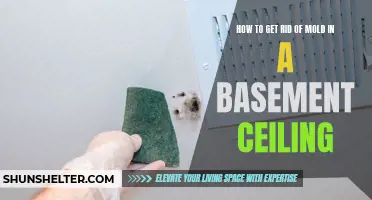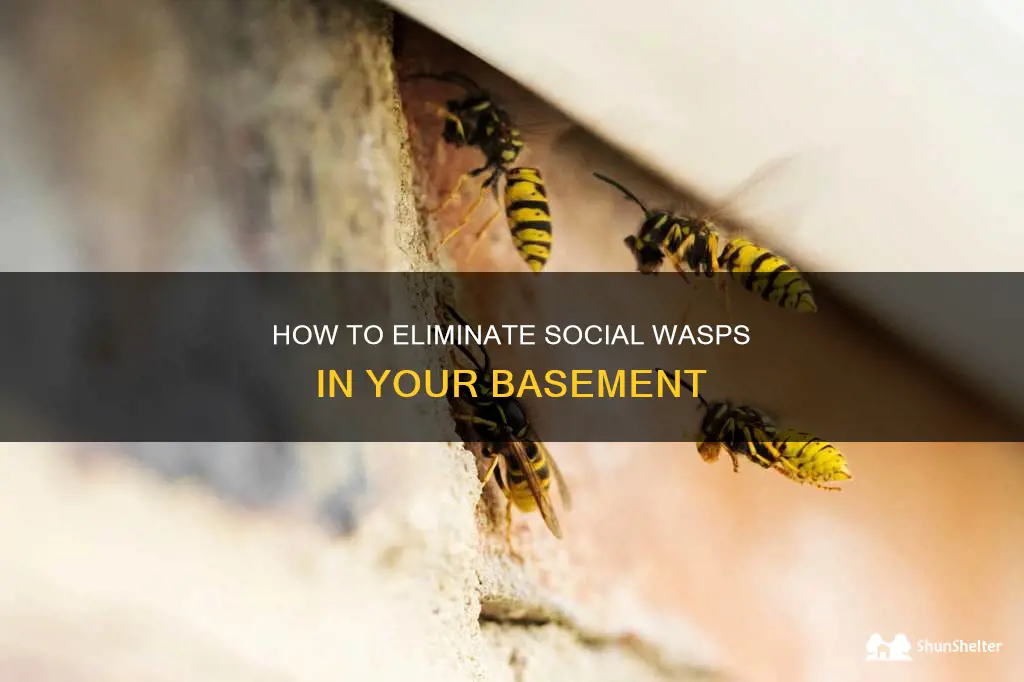
Have you ever experienced the annoyance and potential danger of social wasps invading your basement? If so, fear not! In this guide, we will explore effective methods and tips to help you eliminate these buzzing intruders from your basement, ensuring peace and safety in your home. So, grab your protective gear and get ready to reclaim your space from these unwanted guests!
| Characteristics | Values |
|---|---|
| Wasp species | Various species of social wasps (e.g., yellow jackets, paper wasps) |
| Nest location | Usually found in dark, secluded areas such as basements |
| Nest construction | Made of chewed wood fibers and saliva, forming paper-like nests |
| Nest size | Can vary from small to large, depending on the species and the time of year |
| Number of wasps in a nest | Ranges from a few dozen to several thousand |
| Wasp behavior | Aggressive when disturbed, their stings can be painful and potentially dangerous for allergic individuals |
| Attractants | Sweet scents, food sources, and water |
| Prevention measures | Seal all entry points, maintain cleanliness, remove potential food sources |
| Do-it-yourself methods | Using wasp sprays, vacuuming, trapping, or dusting nests |
| Professional assistance | Hiring pest control experts or beekeepers for safe removal |
| Safety precautions | Wearing protective clothing, working during nighttime, avoiding sudden movements within their vicinity |
What You'll Learn

Identifying the social wasp species in your basement
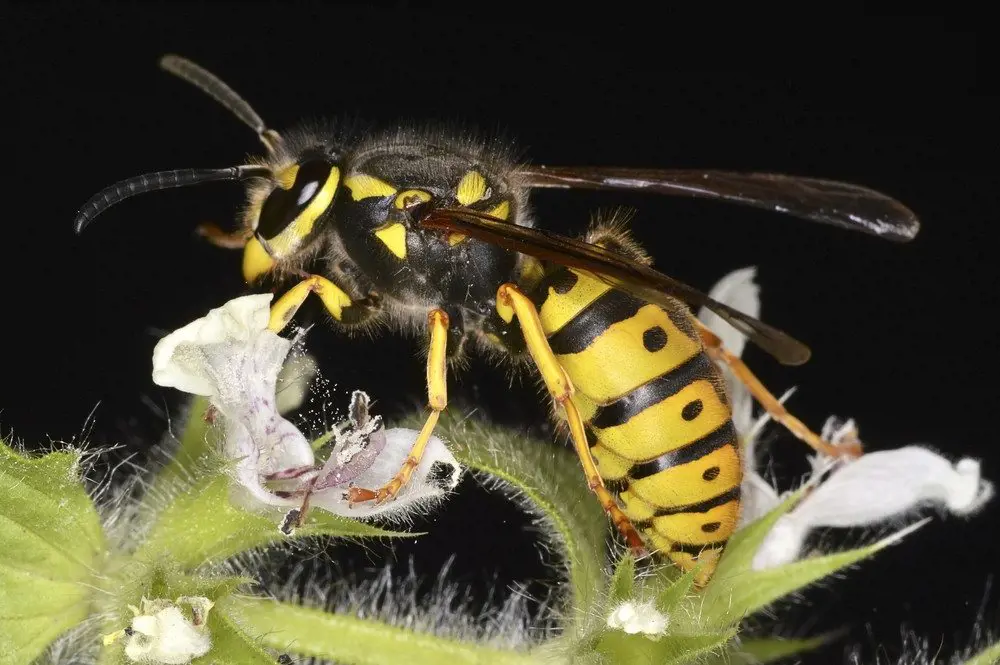
If you've noticed an uptick in social wasp activity in your basement, it's important to identify the species before taking any action. This will help you better understand their behavior, as different species have different nesting preferences and habits. By correctly identifying the social wasp species in your basement, you can choose the most effective method to rid your home of these pests.
Here are some common social wasp species you might find in your basement:
- Yellow Jackets: Yellow jackets are notorious for building nests in wall voids, attics, and underground. They are typically aggressive and can deliver painful stings if their nest is disturbed. Yellow jackets are about half an inch long, have yellow and black bands on their abdomen, and have slender waists.
- Paper Wasps: Paper wasps build umbrella-shaped nests made of a paper-like substance. They hang their nests from eaves, porch ceilings, and other protected areas. Paper wasps are about an inch long, have long bodies with a narrow waist, and are usually reddish-brown or dark brown in color.
- Hornets: Hornets are larger than other social wasps and can grow up to 1.5 inches in length. They build large, paper-like nests usually high up in trees or on buildings. Hornets are typically black with yellow or brown markings. They are known for their aggressive behavior and powerful stings.
Once you have identified the social wasp species in your basement, here are some steps you can take to get rid of them:
- Wear protective clothing: Before attempting any removal or eradication methods, make sure to wear protective clothing. This includes long sleeves, long pants, gloves, and a hat with a veil or netting, if possible. Protecting yourself from stings is crucial to avoid any potential allergic reactions.
- Locate the nest: Carefully inspect your basement to locate the nest. Pay attention to areas where you have seen increased wasp activity. Listen for buzzing sounds or look for wasps flying in and out of cracks, crevices, or holes in the walls or ceiling.
- Choose a removal method: Depending on the species and accessibility of the nest, you can choose from several methods:
A. Dust and aerosol insecticides: If the nest is easily accessible, consider using a dust or aerosol insecticide labeled for wasp control. This method allows for direct application to the nest and is generally effective for smaller nests.
B. Nest removal: For nests that are within reach, you can physically remove them using a long-handled tool, such as a broom or a plastic bag. Seal the nest in a plastic bag and dispose of it in an outdoor trash can or bury it in the ground away from your home.
C. Professional pest control: If the nest is located in a hard-to-reach area or if you are uncomfortable dealing with wasps on your own, it's best to contact a professional pest control service. They have the knowledge and equipment to safely remove the nest and eliminate the wasps.
Prevent future infestations: Once the wasps are gone, take steps to prevent future infestations. Seal any cracks, gaps, or holes in the walls, ceiling, or foundation of your basement to prevent entry. Keep windows and doors closed or install screens to prevent wasps from gaining access. Additionally, minimize attractants such as food and sugary drinks in your basement.
Remember, dealing with social wasps can be dangerous, especially if you are allergic to their stings. It is always prudent to prioritize your safety and seek professional help if needed.
Effective Ways to Remove Mold in Basement Rafters
You may want to see also

Locating the wasp nest and determining the size
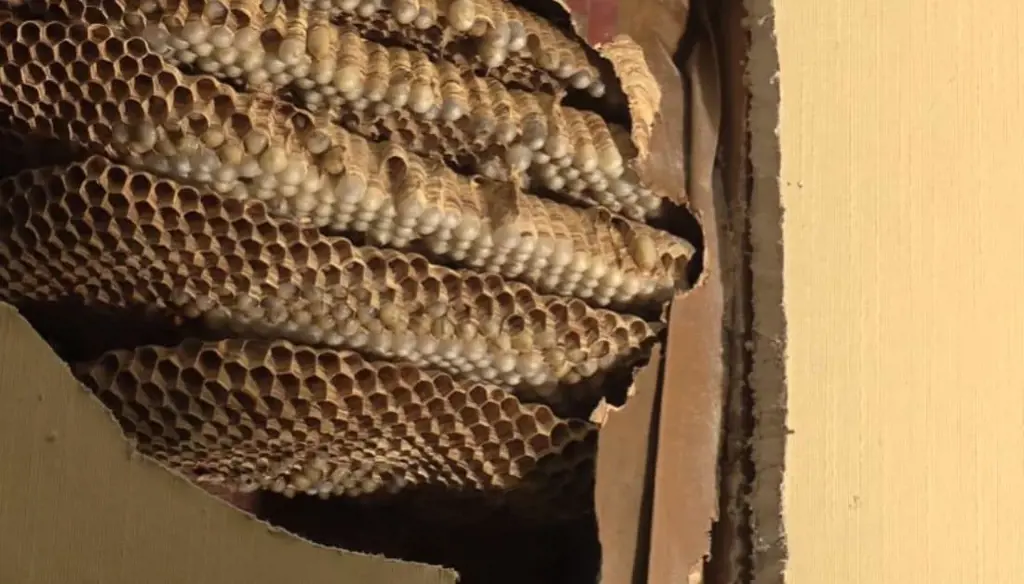
Social wasps can be a nuisance, especially when they invade your basement. Not only can their stings be painful, but they can also cause damage to your property. That's why it's important to locate their nest and determine its size so that you can effectively get rid of them. In this blog post, we will guide you through the process of finding the wasp nest and assessing its dimensions.
- Safety first: Before you begin, make sure to wear protective clothing. This includes long sleeves, pants, gloves, and a hat or hood to cover your head. Additionally, wear goggles to protect your eyes from any potential stings.
- Observe wasp activity: Start by carefully observing the wasp's flight pattern. Take note of where you see them entering and exiting your basement. Wasps are known to create nests in hidden or hard-to-reach places, so this observation will give you an idea of where to concentrate your search.
- Follow the wasps: Once you have identified the general area where the wasps are entering and exiting, carefully follow their flight path. This may require you to crawl or climb into tight spaces, so proceed with caution.
- Look for nest building materials: Wasps use a variety of materials to construct their nests, including wood fibers and saliva. Look for any signs of a nest under eaves, in corners, or on the ceiling. You may also find small pieces of chewed wood or other building materials nearby.
- Listen for buzzing sounds: Wasps make a distinct buzzing sound when they are building their nests. Listen for any unusual sounds coming from hidden areas of your basement. If you hear buzzing, it is a strong indication that you are close to the nest.
- Use a flashlight: Dark corners and hidden spaces can make it difficult to locate a wasp nest. Using a flashlight will help you see into these areas and identify any signs of a nest. Be sure to shine the light in all directions, including up and down, as wasps can build their nests in a variety of locations.
- Confirm the nest location: Once you have identified a potential nest, you can further confirm its presence by observing wasp activity around it. Look for wasps flying in and out of the nest, as well as any signs of aggression or territorial behavior.
- Determine the nest size: To determine the size of the wasp nest, you can estimate the number of wasps entering and exiting the nest in a given time period. Count the number of wasps you see entering or exiting the nest in a minute, and multiply that number by the number of minutes you observe the activity. This will give you an approximate estimate of the size of the nest.
Remember, dealing with a wasp nest can be dangerous, especially if you have an allergy to their stings. If you are unsure about handling it yourself, it is always best to seek professional help. Wasp exterminators have the experience and equipment to safely remove the nest and eliminate the wasps from your basement.
10 Tips to Get Rid of Basement Tenants
You may want to see also

Effective methods for removing the social wasp nest
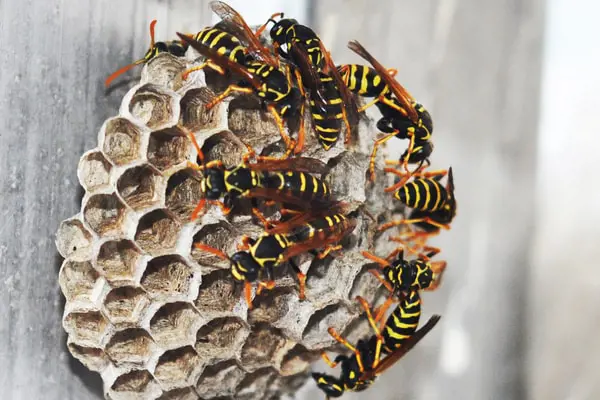
If you've discovered a social wasp nest in your basement, it's essential to remove it as soon as possible to prevent the wasps from causing harm or spreading throughout your home. Social wasps, such as yellow jackets and paper wasps, are known for their aggressive behavior when threatened, so it's crucial to take the appropriate precautions when removing the nest. Here are some effective methods for removing a social wasp nest from your basement:
Safety First
Before attempting to remove the nest, make sure you're wearing protective clothing, including a long-sleeved shirt, long pants, closed-toe shoes, gloves, and a hat with a veil or netting to protect your face. Additionally, it's recommended to work during the early morning or evening when the wasps are less active.
Identify the Wasp Species and Nest Location
Understanding the species of wasps you're dealing with can help you develop an effective removal plan. Different wasp species build nests in various locations, such as underground, in trees, or in enclosed spaces like your basement. Identify the nest's location and ensure you have a clear escape route in case of emergencies.
Seal Off the Area
Before removing the nest, it's essential to seal off the area to prevent the wasps from escaping into other parts of your home. Close any doors or windows leading to the basement and block off any other openings or cracks where the wasps might access other areas of your house.
Apply an Insecticide Dust
Insecticide dust is a commonly used method for eliminating social wasp nests. It's important to choose an insecticide specifically labeled for wasp control. Once you've identified the nest's location, put on your protective gear and carefully apply the insecticide dust directly into the nest entrance, usually a small hole located at the bottom of the nest. The dust will kill the wasps on contact, including those inside the nest.
Spray a Liquid Insecticide
In addition to dust, liquid insecticides can also effectively eliminate a social wasp nest. Choose an insecticide that's specifically made for wasp control and labeled for indoor use. Mix the insecticide according to the manufacturer's instructions and carefully apply it to the nest, saturating the entire nest and any visible wasps. After a few minutes, the wasps should be dead or disoriented, making it easier to remove the nest.
Remove the Nest
Once you've treated the nest with insecticide, it's time to remove it. Using a long stick or pole, gently knock down the nest from its location in the basement. Be cautious not to allow the nest to fall and release any live wasps. Place the nest in a sealed bag or container and dispose of it in an outdoor trash bin.
Clean and Prevent Future Nests
After removing the nest, thoroughly clean the area using soapy water or a household disinfectant. This will remove any remaining wasp pheromones that might attract new wasps to build a nest in the same area. Additionally, inspect your basement for any potential entry points and seal them off to prevent future wasp infestations.
To ensure your safety and the effectiveness of nest removal, it's advisable to consult with a professional pest control company. They have the experience, knowledge, and specialized equipment to handle wasp nest removal safely and efficiently. Remember, always prioritize your safety when dealing with social wasp nests.
Bringing a Motorcycle Safely Down into a Basement: A Comprehensive Guide
You may want to see also

Preventing future infestations of social wasps in your basement
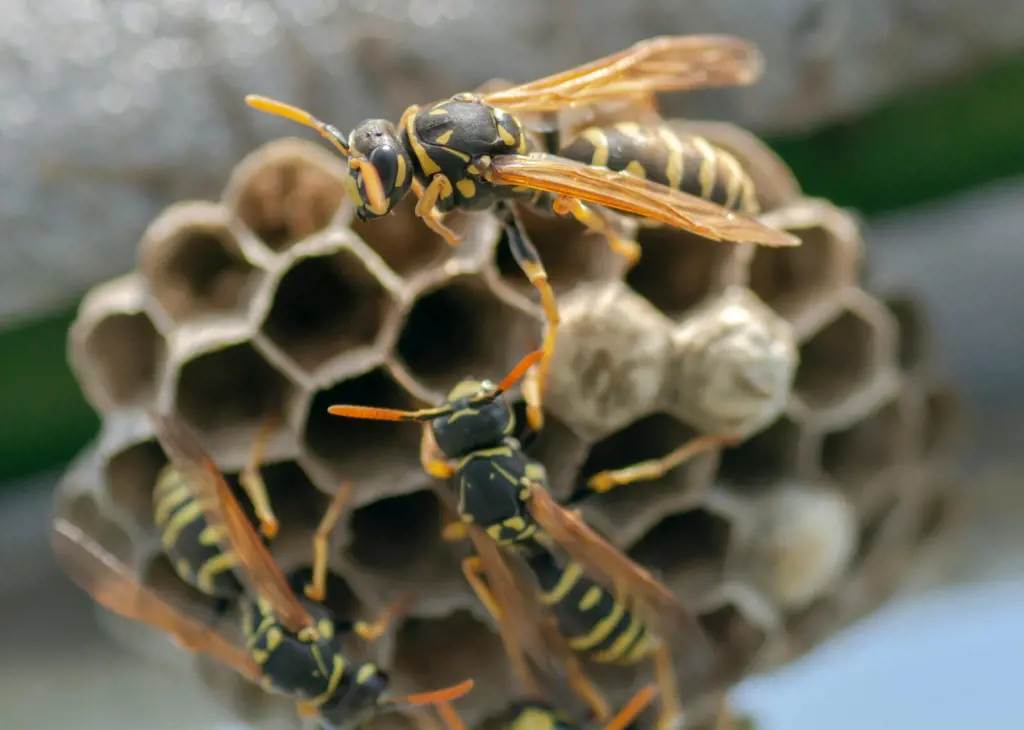
Social wasps, often referred to as yellow jackets, can be a nuisance when they invade your basement. Not only are they a nuisance, but they can also sting when provoked, causing painful reactions in some individuals. If you've recently encountered social wasps in your basement, you'll want to take steps to prevent future infestations. Here are some tips to help you keep these pesky insects out of your basement for good:
Inspect and Seal Entry Points:
The first step in preventing any future infestations is to inspect your basement for any potential entry points. Look for gaps, cracks, or holes in the walls, foundation, or around windows and doors where the wasps could be getting in. Seal these entry points with caulk or another appropriate sealant to keep the wasps out.
Install Window Screens:
Installing window screens is an effective way to prevent social wasps from entering your basement through open windows. Make sure the screens are in good condition and don't have any tears or holes that could allow the wasps to enter.
Keep Windows and Doors Closed:
To minimize the chances of wasps entering your basement, make it a habit to keep windows and doors closed, especially during the warmer months when wasps are most active. If you need ventilation, consider using window fans or air conditioning units that can help circulate the air without inviting wasps inside.
Keep Garbage Cans Sealed:
Wasps are attracted to food sources, including garbage. Make sure your garbage cans have tightly sealed lids to prevent wasps from being lured into your basement by the smell. Regularly empty and clean the cans to remove any food residues that could attract wasps.
Remove Potential Nesting Sites:
Social wasps build their nests in protected areas, such as eaves, attics, and wall voids. Inspect your basement for potential nesting sites and remove them. Common nesting spots include piles of brush, firewood, or other debris near the basement entrance. Store firewood away from the house and keep the area around the entrance of your basement clean and clutter-free.
Remove Fallen Fruits:
Social wasps are also attracted to sweet fruits that have fallen from trees. If you have fruit trees near your basement, regularly clean up fallen fruits to avoid attracting wasps. Dispose of the fruits in sealed bags or containers to prevent wasps from being drawn to the smell.
Avoid Attracting Insects:
Wasps prey on other insects, so reducing the number of insects around your property can indirectly help in preventing wasp infestations. Minimize outdoor lighting to reduce the attractiveness to flying insects and consider using insect repellents or citronella candles when spending time outside.
Seek Professional Help:
If you've taken all the preventive measures, but the wasp problem persists, it may be time to seek professional help. Pest control professionals have the expertise and tools to safely remove wasp nests and deal with infestations. They can also help you identify any potential structural issues that could be allowing the wasps to enter your basement.
By following these preventive measures, you can significantly reduce the chances of future infestations and enjoy a wasp-free basement. Remember, it's essential to take action at the first sign of a wasp problem to prevent it from getting worse.
Exploring the Benefits of Metal on Exterior Basement Walls
You may want to see also
Frequently asked questions
A common method is to use a wasp spray or aerosol insecticide. Spray the nests directly and then seal off any entry points to prevent them from returning.
Yes, you can try using a mixture of dish soap and water or a solution of vinegar and water to spray the nests. Additionally, setting up a trap with a sweet liquid like fruit juice can help lure and capture the wasps.
Seal off any cracks or openings in your basement walls and windows to prevent the wasps from entering. You can also install window screens or insect netting to provide an additional barrier.
It is generally recommended to call a professional pest control service to safely remove the wasp nests. They have the necessary protective equipment and expertise to handle the situation effectively and safely.
After removing the nest, the wasps may take a few hours to a couple of days to completely leave the area. It is important to keep any entry points sealed to prevent them from returning.





